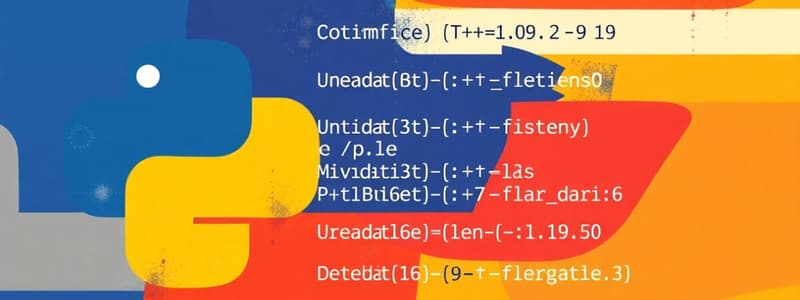Podcast
Questions and Answers
What does the equal sign represent when assigning a value to a variable in Python?
What does the equal sign represent when assigning a value to a variable in Python?
- Assignment operator (correct)
- Mathematical equality
- Type declaration
- Logic comparison
Which statement is true about variable declaration in Python?
Which statement is true about variable declaration in Python?
- Variables must be declared with a specific type.
- Variables need to be defined before they are used.
- Variables can only hold integer values.
- Variables are automatically type-inferred. (correct)
In the example 'a, b, c = 6, 9.3, "Hello"', what are the data types of variables a, b, and c respectively?
In the example 'a, b, c = 6, 9.3, "Hello"', what are the data types of variables a, b, and c respectively?
- Float, Integer, String
- Integer, Integer, String
- Integer, Float, String (correct)
- String, Float, Integer
What is the primary role of a variable in Python?
What is the primary role of a variable in Python?
What Python function is used to determine the length of a string variable?
What Python function is used to determine the length of a string variable?
Which of the following variable names is valid in Python?
Which of the following variable names is valid in Python?
What will be the output of the statement 'print(website)' if the variable website is assigned the value 'github.com'?
What will be the output of the statement 'print(website)' if the variable website is assigned the value 'github.com'?
Why does Python not require variable type declarations?
Why does Python not require variable type declarations?
When using the assignment operator in Python, what does the operation 'first_name = 'Ron Marc'' accomplish?
When using the assignment operator in Python, what does the operation 'first_name = 'Ron Marc'' accomplish?
Which character is suggested for separating words in multi-word variable names in Python?
Which character is suggested for separating words in multi-word variable names in Python?
What will be the output of the command 'print(a, b, c)' if a, b, c are assigned 1, 2, 3 respectively using semicolons?
What will be the output of the command 'print(a, b, c)' if a, b, c are assigned 1, 2, 3 respectively using semicolons?
What happens if you try to assign a value to a variable that starts with a number?
What happens if you try to assign a value to a variable that starts with a number?
What is the purpose of using a dictionary in the given example of person_info?
What is the purpose of using a dictionary in the given example of person_info?
What is a mnemonic variable in programming?
What is a mnemonic variable in programming?
In which case are variable names considered different in Python?
In which case are variable names considered different in Python?
If a variable is declared as 'number = 90', what is the value of 'number' after running 'number = 9.1'?
If a variable is declared as 'number = 90', what is the value of 'number' after running 'number = 9.1'?
Flashcards are hidden until you start studying
Study Notes
Python Variables
- A variable is a named location in the computer's memory that holds data.
- It's like a container for information that can be changed later in your program.
- Mnemonic variables (those easy to remember and associated with their purpose); are recommended to use in programming.
- Variables are declared and assigned values using the
=operator. For example,number = 90.
Python Variable Naming Rules
- Variable names must start with a letter (A-z) or an underscore (_).
- Variable names cannot start with a number (0-9).
- They can only contain alphanumeric characters and underscores.
- They are case-sensitive (firstname, Firstname, FirstName, and FIRSTNAME are all distinct variables).
- Lowercase letters are recommended for variable names.
Standard Python Variable Naming Style
- Python developers use snake_case naming convention, where words are separated by underscores (e.g., first_name, last_name, engine_rotation_speed).
Assigning Values to Variables
- Think of a variable as a name attached to a particular object.
- In Python, you don't need to explicitly declare the type of a variable, as Python is a type-inferred language.
- Python automatically determines the type of a variable based on the assigned value.
Examples of Variable Declaration and Assignment
website = "github.com"assigns the string "github.com" to the variablewebsite.first_name = 'Ron Marc'stores the string "Ron Marc" in the variablefirst_name.number = 90assigns the integer value 90 to the variablenumber.- Multiple variables can be declared and assigned values in one line using commas:
a, b, c = 6, 9.3, "Hello". - Variables can be assigned values from within a dictionary, as in
person_info = {'firstname':'Ron Marc', 'lastname':'Charles', 'country':'Philippines', 'city':'Makati'}
Python Constants
- Python does not have built-in support for constants, which are values that should not change.
- It's considered good practice to name constants in all uppercase letters (e.g.,
PI = 3.14159). - While there is no strong enforcement mechanism for constants, using uppercase naming conventions helps create code that's self-documenting and promotes consistency.
Studying That Suits You
Use AI to generate personalized quizzes and flashcards to suit your learning preferences.




